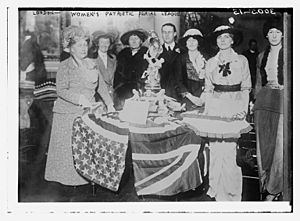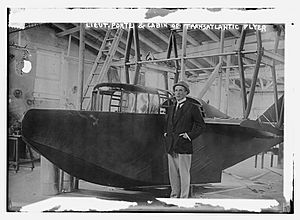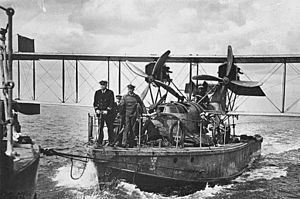John Cyril Porte facts for kids
Quick facts for kids
John Cyril Porte
|
|
|---|---|
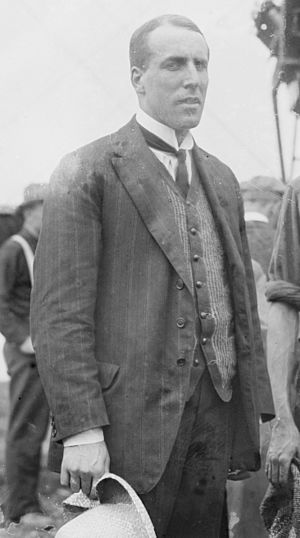
Porte on 22 June 1914, day of the naming ceremony for Wanamaker's America.
|
|
| Born | 26 February 1884 Bandon, County Cork, Ireland
|
| Died | 22 October 1919 (aged 35) Brighton, England
|
| Nationality | British |
| Occupation | Inventor Aviator Company director |
| Known for | Navigation Air racing Transatlantic flight Seaplane Experimental Station Anti-submarine warfare Flying boats |
| Military career | |
| Allegiance | United Kingdom of Great Britain and Ireland |
| Service/ |
Royal Navy British Army Royal Air Force |
| Years of service | 1898–1911 1914–1919 |
| Battles/wars | First World War |
| Awards | Companion of the Order of St Michael and St George Navy Distinguished Service Medal (United States) |
Lieutenant Colonel John Cyril Porte (born 26 February 1884 – died 22 October 1919) was a British pioneer who helped create flying boats. He was very important during the First World War at the Seaplane Experimental Station in Felixstowe, England.
Contents
John Cyril Porte was born in Bandon, County Cork, Ireland, on 26 February 1884. His father was a church minister. When John was six, his family moved to England.
At age 14, in 1898, Porte joined the Royal Navy. He trained on ships like HMS Britannia and HMS Pilot. By 1905, he became a lieutenant. In 1906, he joined the Royal Navy Submarine Service, learning to operate submarines. His first command was HMS B3 in 1908.
Designing Early Aircraft
In 1908, Porte worked with another lieutenant, Wilfred Pirie, to design a glider. They tested it in 1909, launching it like the Wright Brothers did. Their glider was a biplane with two sets of wings, flown by two pilots. This design was quite advanced for its time.
While serving on submarines, Porte became ill with tuberculosis, a serious lung disease. Because of his health, he had to retire from the Navy in 1911.
Learning to Fly
Even though he was ill, Porte loved flying. He built his own Santos-Dumont Demoiselle airplane. In 1911, he earned his pilot's license in France. He was a very skilled and natural pilot.
After leaving the Navy, Porte became a test pilot and director for the British Deperdussin Company. This company was the first to build foreign aircraft in Britain. He invested almost all his money into this business. He flew in air races and became well-known for his flying skills.
Later, he worked for White & Thompson as a designer and test pilot. He married Minnie 'Betty' Miller in 1916.
Dreaming of a Transatlantic Flight
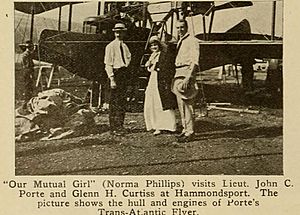
Around 1911, Porte met American aircraft designer Glenn Curtiss. They decided to work together to build an aircraft that could cross the Atlantic Ocean. The Daily Mail newspaper offered a huge prize of $50,000 for the first successful flight.
In 1912, Curtiss built a flying boat called the Flying Fish. Porte suggested adding a special "step" to the bottom of the hull. This step helped the aircraft lift off the water more easily.
In 1914, Porte and Curtiss worked on a new design, funded by American businessman Rodman Wanamaker. They built a prototype flying boat, hoping to win the prize. Porte was supposed to fly and navigate the aircraft with his co-pilot, George Hallett. They planned a route from Newfoundland to the Azores, then to Plymouth, England.
However, their plans were stopped on 4 August 1914. This was when World War I began, and Britain declared war on Germany. Porte had to leave America quickly and return to England.
War Service and Flying Boat Designs
When Porte returned to England, he rejoined the Royal Naval Air Service (RNAS). He was put in charge of pilot training at Hendon Aerodrome.
The British Navy needed aircraft to fight German U-boats (submarines) and Zeppelins in the North Sea. Porte convinced the Navy to buy Curtiss H-4 flying boats. These early planes weren't powerful enough, so Porte helped improve them. He replaced their engines with stronger ones, like the Rolls-Royce Falcon engines. These improved planes were called H-12s or Large Americas.
Developing the Felixstowe Flying Boats
In September 1915, Porte moved to RNAS Felixstowe. He became the commander of the Experimental Flying Wing. Here, he designed and improved many flying boats.
His first design was the Porte Baby. This was a huge, three-engined flying boat. It was the largest flying boat built in the UK between 1915 and 1918.
Porte then took the Curtiss H-4 and gave it a new, better hull. This made it much easier to take off and land on water. He called this improved aircraft the Felixstowe F.1. He did the same with the larger Curtiss H-12, creating the Felixstowe F.2. These Felixstowe designs were much better than the original Curtiss models.
Under Porte's leadership, the Felixstowe station kept making bigger and better flying boats. This led to the F.3 and the F.5. His last design was the massive Felixstowe Fury triplane, also known as the "Porte Super-Baby." It was the largest seaplane and British aircraft of its time.
Fighting Zeppelins and Submarines
The Felixstowe flying boats were mainly used for long patrols. They searched for German warships and submarines. They were also very good at intercepting Zeppelins. To avoid these planes, Zeppelins had to fly much higher.
This led Porte to try something new in 1916: the first composite aircraft. He designed a Porte Baby to carry a small Bristol Scout fighter plane on its back. The idea was that the large flying boat would fly a long distance, then release the smaller fighter. The fighter could then climb quickly to attack enemy Zeppelins.
On 17 May 1916, this system was tested. The fighter plane was successfully released from the Porte Baby. However, this method was found to be too difficult for the rough conditions of the North Sea.
Hundreds of Porte's flying boats were built during the war. They patrolled the English coast and the Mediterranean Sea. They were even sold to the United States for coastal patrols. These planes were armed with torpedoes and depth charges to attack enemy ships and U-boats.
Porte also found a way to increase the range of flying boats. He used a small towing lighter (a type of boat) with a special hull. The flying boat could taxi onto the lighter's deck. Then, a destroyer ship would tow the lighter and flying boat at high speed to the release area.
He even extended this idea to launch fighter planes. A Sopwith Camel fighter was placed on a thirty-foot deck on a lighter. On 11 August 1918, Lieutenant S. D. Culley successfully took off from a lighter towed by HMS Redout. Culley used his fighter to intercept and destroy a German Zeppelin L 53. After the fight, he landed his plane next to the lighter in the water.
During his time at Felixstowe, Porte held various ranks in the Navy and Royal Air Force, including lieutenant commander and lieutenant colonel. He was a very important figure in British aviation during the war.
Later Life and Legacy
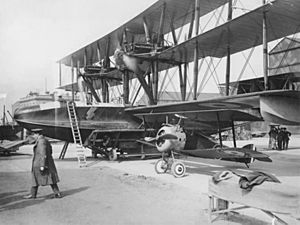
After the war, Porte was still very ill. He joined the Gosport Aircraft Company in August 1919 as their chief designer. He had many new ideas for flying boats, including designs with skis or hydrofoils for better water take-offs. He hoped to convert war-surplus flying boats for civilian use, like carrying passengers and cargo.
However, due to his poor health and lack of government funding, many of his new designs were never built.
John Cyril Porte died suddenly in Brighton, England, on 22 October 1919, at the age of 35. He passed away from pulmonary tuberculosis, the illness that had affected him for years. He was buried in West Norwood Cemetery. His monument has an epitaph that says, "Colonel Porte was the inventor of the British flying boats."
Honors and Recognition
Even in his last moments, Porte was thinking about new inventions. His death was a great loss to the aviation world. Many people praised his strong will and dedication despite his illness.
Walter Raleigh, in his book The War in the Air, said that Porte's name should be included in any list of people who saved the country during the First World War.
On 19 September 1919, shortly before he died, Porte was awarded the U.S. Navy Distinguished Service Medal by the President of the United States, Woodrow Wilson. This award recognized his important pioneering work.
In 1922, Porte's widow received an award of £1500 from the Royal Commission on Awards to Inventors. This was for the information he shared with the US Government about his inventions and designs for flying boats.
Porte's work had a lasting impact. Many of the successful Short Brothers flying boats built between 1930 and 1950 were based on his pioneering designs.
|


